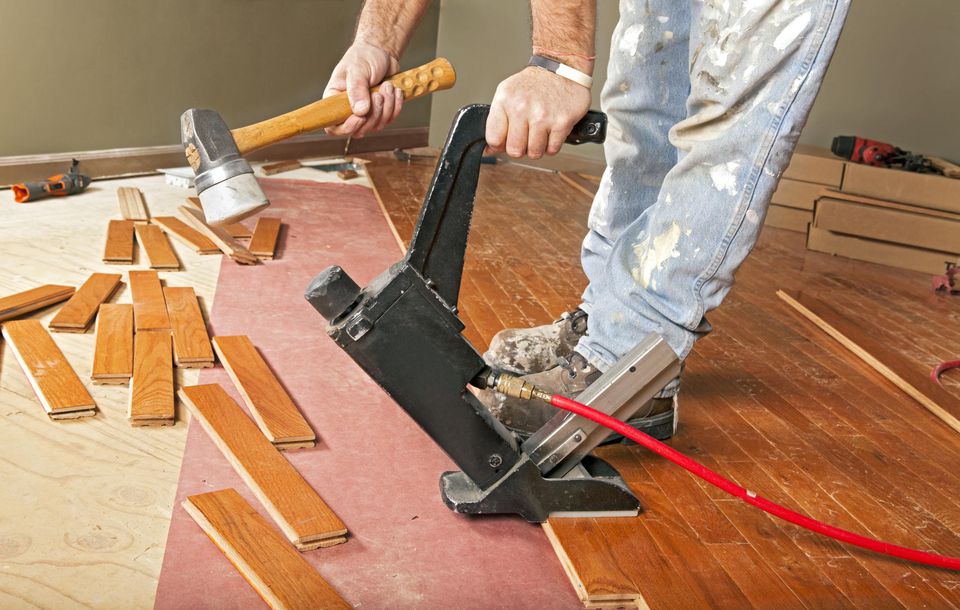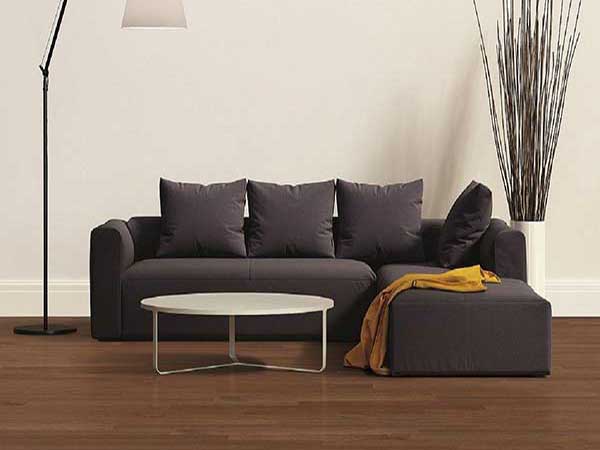Hardwood Floor Installation Costs
The average cost to install hardwood flooring is $4,213 with most homeowners spending between $2,311 and $6,115. On the low end, you can expect to pay $6 to $11 per square foot, and on the high-end prices range from $12 to $23 per square foot for both materials and installation. The installation includes finishing, trim, and removal of your old floor.
Hardwood Flooring Installation Cost Per Square Foot
Hardwood flooring installation costs $6 to $23 per square foot with most homeowners spending between $8 and $15 per square foot on average. The main pricing factors include the type of wood you select and labor costs for professional installation.
Average Labor Cost For Installing Hardwood Floors
The average labor cost for installing hardwood floors ranges from $3 to $9 per square foot to hiring a professional contractor. Expect labor costs to make up approximately 50% of your total project cost. Always get multiple bids from various hardwood flooring contractors so you can make an educated decision.
How Much To Install Hardwood Floors On 1,000 Sq. Feet?
The average cost to install hardwood floors on 1,000 sq. feet is between $6,115 and $10,140 with most homeowners spending about $8,127 for materials and professional labor.

Hardwood Stairs Cost
Installing hardwood stairs costs between $100 and $200 per step on average, which includes all materials and professional labor. Typically a flight of stairs has 12 to 15 steps, which would be a total of $1,200 to $3,000.
Traditional Wood Flooring Costs
The cost of new wood floors ranges from $6 to $13 per square foot while engineered hardwood is slightly more expensive at an average of $6 to $15 per square foot for both materials and installation. Traditional flooring is solid wood without any layers – in comparison to engineered wood, which is constructed with multiple layers of hardwood and plywood. Both are durable, high-performance options, so it just depends on your personal preference.
| Floor Grade | Materials Cost (SF) | Labor Cost (SF) | Total Cost(SF) |
| Lowest tier | $3 to $6 | $3 to $5 | $6 to $11 |
| Middle tier | $5 to $10 | $4 to $8 | $9 to $18 |
| Highest tier | $8 to $15 | $4 to $8 | $12 to $23 |
The hardest hardwoods, such as walnut and oak are the most durable. However, they are also more costly. Although prices will vary depending on the supplier, you can expect three key pricing groups based on the hardness and rarity of the wood.
Wood Flooring Grades
Wood flooring typically comes in 3 different grades. Also, wood floors are available in narrow boards or planks. These range of approximately 3 inches to 7 inches in width respectively. In terms of how much traditional wood flooring costs, the most significant factor is, of course, the type of wood you select.
- Lowest tier – Soft woods, including pine and poplar, generally cost anywhere from $3 to $6 per square foot, as well as an additional $3 to $5 for installation.
- Middle tier – These woods will be hardwood options, which are relatively common, including oak, teak, or American cherry. In comparison, you can expect to pay anywhere between $5 to $10 a square foot for the flooring itself, in addition to around $4 to $8 per square foot for professional installation.
- Highest tier – The most expensive hardwoods are those that are rare and/or exotic, such as tigerwood, mahogany, or Brazilian walnut. These typically cost anywhere between $8 to $15 per square foot, in addition to $4 to $8 per square foot for installation.
Engineered Hardwood Costs
Installing engineered hardwood costs $6 to $11 per square foot on the low end, all the way up to $12 to $23 per square foot for exotic hardwoods. When comparing traditional and engineered wood, the main difference is in the construction of the wood itself. As discussed, traditional wood is just solid wood, prepared into boards or planks.
In contrast, engineered wood is constructed with multiple layers of hardwood and plywood. Based on the way these layers are created and positioned, engineered hardwood helps prevent any bowing or warping of the wood following exposure to moisture.
Measurements
Measuring your floor to determine how much hardwood material you need is simple. Divide the room into squares or rectangles if it contains bump outs, closets, or angles. Measure the length and width of each section in inches. Multiply the two measurements together to get the total number of square inches in that section.
Divide this by 144 to get the total number of square feet in that section, then add the sections together and round up to the nearest whole number. To account for waste, add an additional 10% to your total to get the total amount of hardwood you’ll need for your floor.
Prep work
Before a hardwood floor can be laid, there’s some degree of prepping that needs to go into the project. Old floors may need to be removed if this is an existing home, and the subfloor may need to be replaced.
All hardwood floors should ideally be installed on top of ¾-inch plywood. However, engineered wood floors can be installed over concrete and below grade, as they are less prone to being affected by moisture. In this case, the floors would need to be floated, or interlocked plank to plank, rather than being nailed or stapled to the subfloor. Plywood subfloors cost between $8 and $16 per square foot; most people only use concrete if it is already installed.
If there is excessive moisture on a concrete floor, then a moisture barrier may be recommended to help prevent this excess moisture from damaging the hardwood. A roll of 200 square foot moisture barrier costs about $20.
In addition to the subfloor , any baseboards or moldings will also need to be removed. Hardwood is installed right up to the walls, with a ⅛-inch expansion gap. The baseboard is put back on after the floor is finished, covering this gap and hiding it from view. Doors, thresholds, and transition strips may also need to be removed if they will be in the way, and any furniture needs to be removed from the room as well.
If you are choosing an unfinished floor, which will be finished on site, then precautions should also be taken to protect furnishings in adjacent rooms. Covers should be used to protect them from the dust involved in the finishing of the hardwood.
Find Local Professionals for pretty much everything at Thumbtack.com
Additional considerations and costs
- Pet claws can scratch and wear away at hardwood floors. Choosing a wood with a high Janka score or a material with a resin-infused finish can help prevent this. Look at the warranty of the material to find out what may be covered.
- Prefinished flooring cuts down on installation time, but costs more at time of purchase. This evens out with unfinished flooring which costs more to install, but is cheaper to buy.
- Hardwood should always be installed by a professional. However, if you want to DIY, engineered hardwood with a click-lock installation may be easier.
- Always get at least three estimates when having new flooring installed to get the best possible person for the job.
- To save money, purchase your own materials and do the prep work such as removing furniture and the old flooring before the installation begins.
- Some installers will remove furniture for you, but most will not. It’s best to have this done before the installer arrives to avoid additional fees of up to $200 per room.
- Old flooring may be removed by the installer at a further rate of $6-$8 per square foot. If the flooring contains asbestos 8, however, abatement may be necessary before continuing with costs starting at $200-$400 per hour.
- If your hardwood has become dull, it can be refinished. The average cost of refinishing your flooring is around $3,650.
- Unless otherwise specified by the manufacturer, wood flooring must be allowed to acclimate to the temperature and humidity levels of your home before installation. This is to prevent expansion or contraction after installation, which may cause warping.
- If the subfloor has become wet, it is imperative that it dries prior to installation of hardwood flooring. Inspect the subfloor to insure it’s dry and flat. Check the subfloor for squeaks or loose panels and shim or refasten as necessary before installing the hardwood flooring. The installer should inspect the subfloor for smoothness along joints between panels. Any ridges at panel edges should be sanded smooth prior to installation of the hardwood flooring, using a heavy duty floor sander with a moderately coarse grit sandpaper. Insuring the subfloor is smooth and dry may increase costs for installation depending on the issues.
Lastly the contractor costs can create the greatest variance. When selecting a contractor to work on your home, be diligent to check into their references. Contractors can have huge variances in rates based on the size and shape of the space. Make sure you review the entire layout, and budget, with your contractor to avoid surprise costs down the road.



